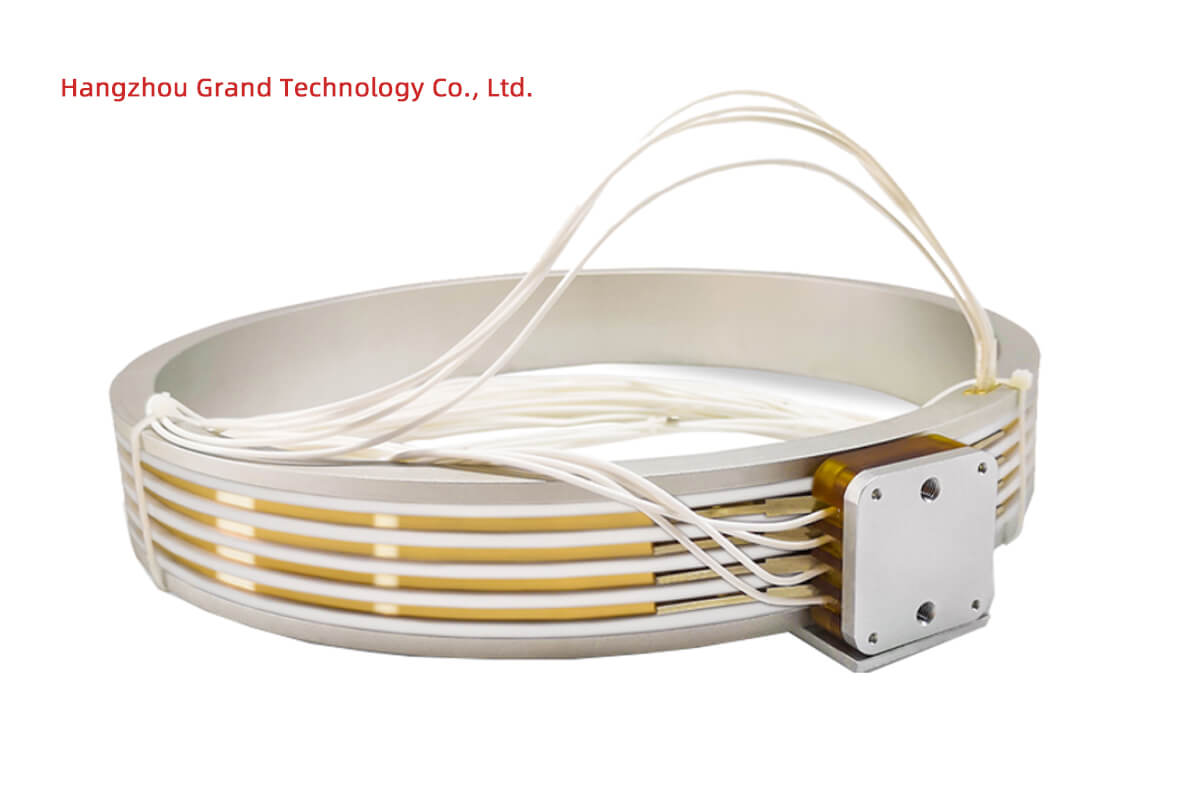Introduction
Slip rings play a pivotal role in the world of electronics and electromechanical systems. Consider them as the unsung heroes which enable the transmission of power, electrical signals, and data between stationary structures and the parts that rotate. As such, they find diverse applications in wind turbines, CCTV cameras, MRI machines, cable reels, and many more systems. Yet, when acknowledging their contribution to these rotating systems, we often tend to ignore some of the crucial specifics that revolve around slip rings, one of them being the ‘slip ring rated voltage.’ This factor is quite a determinant of a slip ring’s functionality and safety.
This comprehensive guide will take you through the intricacies of the slip ring rated voltage. We’ll elucidate what it implies, how it drives the decision-making process for choosing a suitable slip ring, and its varied applications across an array of voltage values. We would also look at the security implications associated with the rated voltage of slip rings, evaluate the rated voltage data across different types of slip rings, and walk you through some essential buying tips. Finally, the guide rounds off with an FAQ section to clear some common queries related to the rated voltage of slip rings.
What Are Slip Ring Rated Voltage?
When it comes to slip rings, the term ‘rated voltage’ carries a significant amount of weight. Essentially, it refers to the upper threshold or the maximum operating voltage that a slip ring can handle. In other words, the rated voltage denotes the highest voltage that the slip ring can work under, without causing any system malfunction or damaging the constituent materials that make up the overall structure.
Think of the rated voltage as a safety parameter. It is a cut-off point set by the manufacturer, the crossing of which can spell potential hazards for the application or system linked to the slip ring. A crucial factor derived from multiple elements, the rated voltage depends heavily on aspects such as the design of the slip ring, the constituents of the materials used in its construction, the quality of insulation implemented, and the intricacies of the manufacturing procedure followed.
For a slip ring to function optimally, it is pivotal that one chooses a rated voltage that aligns with the electrical requirements of the proposed application. This decision aids in preventing situations where a slip ring might be working beyond its capacity, which subsequently leads to implications like dielectric breakdown or insulation failure. Such occurrences can culminate into overall system damage, striking a fatal blow to both the slip ring and the devices connected to it.
Therefore, understanding and considering the concept of rated voltage while selecting a slip ring is of paramount importance. It lays a solid foundation for the slip ring to fulfill its purpose of facilitating seamless energy and data transmission between the stationary and rotating components of a system.
How to Choose the Appropriate Slip Ring Rated Voltage?
Selecting the right slip ring rated voltage is as much an art as it is a science. It demands a meticulous consideration of multiple factors that influence the performance, safety, and longevity of a slip ring. Here, we delve deeper into the four key points that can help you make an informed choice while identifying an appropriate rated voltage for the slip ring:
System Requirements
The foremost step in selecting the ideal slip ring rated voltage involves getting a clear grasp of the voltage requirements of the application or system where the slip ring would be implemented. Conduct a thorough analysis to determine the necessary voltage rating that ensures unfaltering performance and maintains a safe operating environment for the connected components. This information lends invaluable guidance in arriving at a well-founded decision.
Operating Environment
The surrounding conditions that the slip ring is exposed to play a significant role in influencing its rated voltage. Elements such as temperature, humidity, and altitude, when coupled with other factors like the presence of dust, vibrations, or corrosive agents, have a direct bearing on the type of rated voltage a slip ring can withstand. By acknowledging these environmental factors, you can choose a slip ring that is well-suited to endure the harshest conditions it is likely to encounter.
Type of Load
The nature of the load connected to the slip ring also holds the key to deciding on a suitable rated voltage. Divisible mainly into three categories– resistive, capacitive, and inductive loads – the performance of each type is contingent on the voltage conditions they are subjected to. For instance, capacitive and inductive loads can potentially induce transient voltage surges. Therefore, selecting a slip ring rated voltage should be in tandem with the characteristics of the type of load linked to the system.
Safety Margins
Leaving something to spare by opting for a slip ring with a slightly higher rated voltage than what your application demands, is always a wise idea. A cushion in the form of a safety margin helps account for unexpected voltage fluctuations and provides room to accommodate future system upgrades. A slip ring that exhibits a rated voltage with an adequate safety margin is not only a safer bet but also contributes to enhanced performance in the long run.
By carefully examining these four crucial aspects, you can gauge the appropriate slip ring rated voltage that not only serves your application needs but also ensures a safe and long-lasting operation.
Application of Slip Ring Rated Voltage with Different Values
Slip ring rated voltage, framed in various values, finds differing applications according to the power needs of different systems. Let’s delve into what specific applications low, medium, and high voltage slip rings cater to:
Low Voltage Slip Rings
Low-voltage slip rings operate typically at a maximum voltage threshold of up to 48 volts. They are compact, simple in design, and work efficiently at low electric potentials. As such, these slip rings are designed for small-scale applications where power requirements are relatively lesser. For instance, robotics, certain types of control systems, CCTV cameras, rotary sensors, miniature precision devices, and medical devices like endoscopy equipment harness the utility of low-voltage slip rings. Moreover, these slip rings demonstrate high performance and serve the purpose in applications where space constraints are a critical factor.
Medium Voltage Slip Rings
Treading in the middle ground, medium voltage slip rings are often rated between 100 volts and 1,000 volts. These slip rings possess a more robust design and can handle higher currents, making them suitable for medium-scale industrial applications. For instance, onshore and offshore wind turbines often use medium voltage slip rings to transmit power from the nacelle to the tower. Additionally, they are often employed in marine applications such as onboard ships for power transmission to rotating radar antennae. These slip rings offer reliability and durability while maintaining a moderate physical footprint.
High Voltage Slip Rings
Catering to heavy-duty applications, high-voltage slip rings come with a rated voltage often exceeding 1,000 volts. These slip rings are engineered to handle high-voltage applications with excessive power demands. They feature large-scale industrial machinery, power distribution and transmission systems, construction equipment, and high-capacity electric motors. They exhibit a rugged design to operate efficiently under harsh conditions and have superior insulation to safely and effectively deal with high voltages. The applications necessitating high-voltage slip rings predominantly revolve around high-power transmission and large rotational devices.
Each of these variants in slip ring rated voltage levels carry out a distinctive role, catering to different power requirements and application scales. Understanding their specific applications can help in making an informed choice for the right rated voltage that aligns with your application needs.
Slip Ring Rated Voltage and Security Risks
Slip ring rated voltage plays a critical role in mitigating security risks. Operating a slip ring above its rated voltage poses a multitude of potential hazards. It’s essential to comprehend these risks to select a suitable rated voltage and ensure the safety and proper functioning of both the slip ring and the connected devices.
Here is an insight into the security risks associated with exceeding a slip ring’s rated voltage:
Electrical Shock
When a slip ring operates beyond its rated voltage, the chance of electric shock to the users, maintenance personnel, and even nearby equipment increases significantly. An electric shock can not only injure or be fatal to human operators but also cause irreparable damage to the connected devices.
Thermal Damage
Exceeding the rated voltage leads to higher currents and increased power dissipation. This scenario results in the slip ring and its components heating up. Excessive heat buildup can cause thermal damage or overheating to the slip ring, potentially affecting the performance, mechanical strength, and longevity of connected devices and components.
Insulation Failure and Dielectric Breakdown
All slip ring designs rely on effective insulation to prevent inadvertent electrical discharges between neighboring conductors. However, applying a higher voltage than the slip ring is rated for might cause the insulation to break down, leading to electrical arcs and short circuits. Consequently, it increases the risk of fires and permanent damage to both the slip ring and the connected systems.
Unreliable Performance and Premature Wear
Operating a slip ring above its rated voltage can stress its materials and components, which in turn can result in erratic performance and accelerated wear. The slip ring may lose efficiency and require more frequent maintenance or even replacement, leading to increased costs and potential downtime for the entire system.
By understanding the significance of slip ring rated voltage, you can choose the optimal voltage level necessary for your application, mitigating these security risks and ensuring the safety, reliability, and longevity of your slip ring and connected systems.
Slip Ring Rated Voltage Data of Different Types of Slip Rings
Capsule Slip Ring
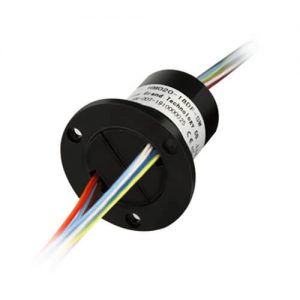
Capsule slip rings are often offered in a compact size with flange-like miniature slip rings, used for electrical power transmission and data transfer between a stationary and a rotating part. Capsule Slip Rings also have the rotor, stator, brush block, bearing, and housing. They are easily installed and widely used in small and medium-sized equipment, such as speed dome cameras, intelligent toys, stage lights drones, etc.
Through Hole Slip Ring
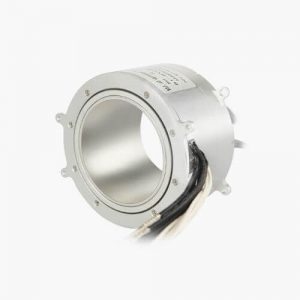
Through hole slip ring is a kind of slip ring with a hole in the center. Same meaning as a through-bar slip ring, sometimes called a hollow shaft slip ring. Through hole slip ring totally meets with continuous transmission of power, signals, weak current, high current, and high voltage under 360-degree unrestrained rotations. Low torque, low electrical noise, low loss, and easy maintenance as the main features.
The process of manufacturing and principle are similar to other slip rings. Power, signals, and other data are transmitted from the fixed position to the rotating position through the contact between the brush and the contact. Gold brush and contact will increase the working life. The basic technical parameters of a hole/bore slip ring mainly include bore outer diameter, bore inner diameter, length, circuits, voltage, current, maximum speed, etc. The length is variable and can be customized arbitrarily, while the outer diameter and inner diameter have some standard dimensions in through hole electrical slip rings industry. The number of circuits is the one core parameter for this series of products, the larger the number of circuits, the more complex the manufacturing process, and the higher the price cost.
Model | Picture | No. of Rings | ID(mm) | OD(mm) | Rated Current | Rated Voltage | |
1-12 | 12 | 33 | 2A | 0~240V | |||
1-24 | 12 | 54 | 5A | 0~240V | |||
1-10 | 20 | 60 | 2A~10A | 0~380V | |||
1-48 | 25.4 | 78 | 2A~10A | 0~380V | |||
1-48 | 38.1 | 99 | 2A~15A | 0~380V | |||
1-10 | 50 | 75 | 2A~12A | 0~380V | |||
1-72 | 50 | 120 | 5A~20A | 0~380V | |||
1-96 | 60 | 135 | 5A~20A | 0~380V | |||
1-96 | 70 | 155 | 5A~20A | 0~380V | |||
1-96 | 80 | 180 | 5A~20A | 0~380V | |||
1-96 | 90 | 190 | 5A~20A | 0~380V | |||
1-96 | 100 | 203 | 5A~20A | 0~380V | |||
1-96 | 120 | 250 | 5A~20A | 0~380V | |||
1-96 | 150 | 300 | 5A~20A | 0~380V | |||
1-96 | 180 | 332 | 5A~20A | 0~380V | |||
1-96 | 200 | 350 | 5A~20A | 0~380V | |||
1-96 | 250 | 407 | 5A~20A | 0~380V | |||
1-96 | 300 | 490 | 5A~20A | 0~380V | |||
1-96 | 400 | 632 | 5A~20A | 0~380V |
Miniature Slip Rings
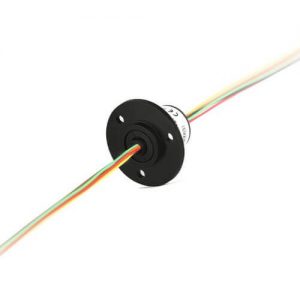
A miniature slip ring assembly is specially designed for small installation spaces. Also called a small slip ring, mini slip ring, compact slip ring, or micro slip ring. A miniature slip ring is the extension of a capsule slip ring and through the through-bore slip ring. The miniature package units have been designed to offer an economical and compact solution for signal and power transmission between the rotor and stator side. Shaft or flange are the two main mounting methods.
High Temperature Slip Ring
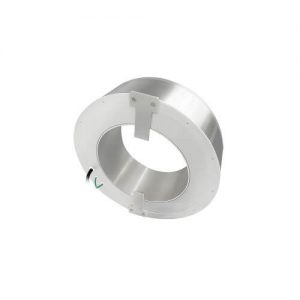
The slip ring can work stably under a 100~250℃ high-temperature environment, even above 250℃.
Model | No. of Rings | ID(mm) | OD(mm) | Rated Current | Rated Voltage | |
1-12 | 12.0 | 33.0 | 2A | 0~240V | ||
1-24 | 12.7 | 54.0 | 5A | 0~240V | ||
1-10 | 20.0 | 60.0 | 2A~10A | 0~380V | ||
1-48 | 25.4 | 78.0 | 2A~10A | 0~380V | ||
1-48 | 38.1 | 99.0 | 2A~15A | 0~380V | ||
1-72 | 50.0 | 120.0 | 5A~20A | 0~380V | ||
1-96 | 60.0 | 135.0 | 5A~20A | 0~380V | ||
1-96 | 70.0 | 155.0 | 5A~20A | 0~380V | ||
1-96 | 80.0 | 180.0 | 5A~20A | 0~380V | ||
1-96 | 90.0 | 190.0 | 5A~20A | 0~380V | ||
1-96 | 100.0 | 203.0 | 5A~20A | 0~380V | ||
1-96 | 120.0 | 250.0 | 5A~20A | 0~380V | ||
1-96 | 150.0 | 300.0 | 5A~20A | 0~380V | ||
1-96 | 180.0 | 332.0 | 5A~20A | 0~380V | ||
1-96 | 200.0 | 350.0 | 5A~20A | 0~380V | ||
1-96 | 250.0 | 407.0 | 5A~20A | 0~380V | ||
1-96 | 300.0 | 490.0 | 5A~20A | 0~380V | ||
1-96 | 400.0 | 632.0 | 5A~20A | 0~380V |
PCB Slip Ring
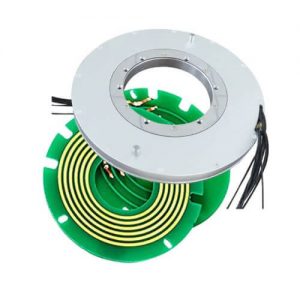
PCB slip ring is a kind of pancake slip ring, also called ultrathin flat slip ring. A common form of flat slip ring and made up of two parts, ring surface and brush assembly. The ring surface circuit board with an ultra-thick copper layer, then copper plating, and hard gold plating, so the PCB slip rings have high hardness and wear resistance features.
1 Passage Pneumatic + Electrical Rotary Joints
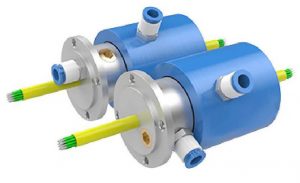
◆ Support M5, G1 / 8, G1 / 4, G3 / 8, G1 / 2, G3 / 4, G1 thread for pneumatic
◆ Dynamic sealing technology
◆ With NSK high precision bearing
◆ Abrasion resistant, low torque, high speed
◆ Can be combined to transfer 2~96 circuits power and signal
| Electrical Data | Mechanical Data | ||
|---|---|---|---|
| Rated Voltage | Power: 0~440 VAC/VDC Signal: 0~240 VAC/VDC | Max. Speed | 400RPM |
| Insulation Resistance | Power: ≥1000MΩ/500VDC Signal: ≥1000MΩ/500VDC | Max. Pressure | 10Bar |
| Insulation Strength | 500VAC@50Hz, 60s | Working Temperature | -30℃~+80℃ |
| Lead Wires | Standard (adjustable) | Working Humidity | 0~85% RH |
| Lead Length | Standard 300mm (adjustable) | Housing Material | Aluminum Alloy |
| Electrical Noise | <0.01Ω | Protection Grade | IP51 |
10 Passage Pneumatic/Hydraulic + Electrical Rotary Joints
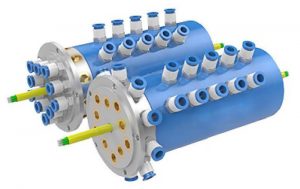
◆ Support M5, G1 / 8, G1 / 4, G3 / 8, G1 / 2, G3 / 4, G1 thread for pneumatic
◆ Dynamic sealing technology
◆ With NSK high precision bearing
◆ Abrasion resistant, low torque, high speed
◆ Can be combined to transfer 2~96 circuits power and signal
| Electrical Data | Mechanical Data | ||
|---|---|---|---|
| Rated Voltage | Power: 0~440 VAC/VDC Signal: 0~240 VAC/VDC | Max. Speed | 400RPM |
| Insulation Resistance | Power: ≥1000MΩ/500VDC Signal: ≥1000MΩ/500VDC | Max. Pressure | 10Bar |
| Insulation Strength | 500VAC@50Hz, 60s | Working Temperature | -30℃~+80℃ |
| Lead Wires | Standard (adjustable) | Working Humidity | 0~85% RH |
| Lead Length | Standard 300mm (adjustable) | Housing Material | Aluminum Alloy |
| Electrical Noise | <0.01Ω | Protection Grade | IP51 |
Buying Tips about Slip Ring Rated Voltage
Investing in a slip ring requires an understanding of its key parameters. To make an informed decision, consider the following buying tips related to slip ring rated voltage:
Understand Your Application Requirements
Begin by assessing your application needs. Determine the voltage range required for your system, and select a slip ring rated voltage that aligns with those requirements. Consider factors such as power transmission, load type, and operating conditions. By opting for a slip ring with a suitable rated voltage, you can ensure optimal performance without jeopardizing the safety and reliability of both the slip ring and the connected devices.
Consider Safety Margins
When investing in a slip ring, it’s prudent to go for one with a slightly higher rated voltage than your application’s requirements. This additional safety margin can help protect your system in the event of unforeseen voltage fluctuations, allowing it to operate efficiently without straining the components. It also provides room for future upgrades or expansions without the need to purchase a new slip ring.
Select a Reputable Manufacturer
Last but not least, it’s crucial to choose a reputable and experienced manufacturer. A reliable manufacturer can help you navigate the nuances of selecting the right slip ring rated voltage and offer essential advice on proper installation and maintenance. Furthermore, a trustworthy manufacturer can provide guarantees and warranties, ensuring a reliable and long-lasting product.
Bear these tips in mind when purchasing a slip ring, as they can serve as a valuable guide that helps you choose the optimal rated voltage for your specific application, maintaining the safety and durability of the entire system.
Conclusion
Choosing the right slip ring rated voltage involves careful examination of system requirements, the operating environment, and the nature of the load, and allowing for adequate safety margins. A clear understanding of these factors can help in selecting an optimal slip ring that ensures maximum performance while maintaining safety and durability.
In sum, to make an informed decision on the appropriate slip ring rated voltage, it is necessary to understand the intricacies of these factors. This will not only ensure the slip ring serves its function efficiently but also help in avoiding potential risks, contributing to the safety and long-term operation of the entire system.
FAQ About Slip Ring Rated Voltage
Q: What happens if a slip ring operates above its rated voltage?
A: Operating a slip ring above its rated voltage may result in dielectric breakdown, insulation failure, electrical shock, thermal damage, and potential damage to the slip ring and connected devices.
Q: Can slip rings handle voltage fluctuations?
A: Well-designed slip rings can accommodate short-term minor voltage fluctuations. However, it is essential to choose a slip ring with a rated voltage that has a safety margin exceeding the expected voltage fluctuations in your system.
Q: Are slip ring rated voltages the same as insulation voltage?
A: No, rated voltage refers to the maximum operating voltage, while insulation voltage is the maximum voltage that the insulating material can withstand without breaking down. The insulation voltage should be higher than the rated voltage for safety reasons.
Q: Can I use multiple slip rings in series to increase the overall rated voltage?
A: While connecting slip rings in series can technically increase the overall rated voltage, this may not be an ideal solution, as it can compromise system efficiency and increase complexities in maintenance and installation. Instead, choose a slip ring with a suitable rated voltage to match your application’s requirements.
See What We Can Do

